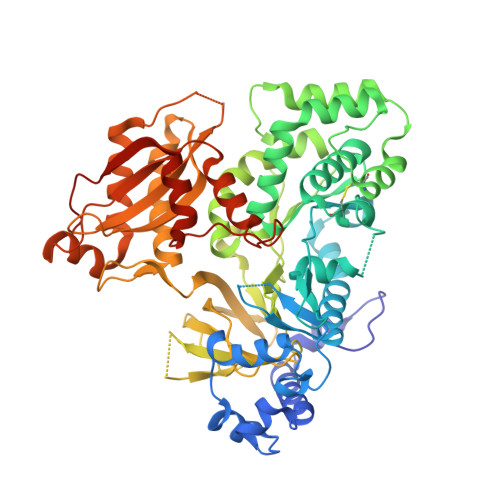Arabidopsis thalianaGH3.15 acyl acid amido synthetase has a highly specific substrate preference for the auxin precursor indole-3-butyric acid.
Sherp, A.M., Westfall, C.S., Alvarez, S., Jez, J.M.(2018) J Biological Chem 293: 4277-4288
- PubMed: 29462792
- DOI: https://doi.org/10.1074/jbc.RA118.002006
- Primary Citation of Related Structures:
6AVH - PubMed Abstract:
Various phytohormones control plant growth and development and mediate biotic and abiotic stress responses. Gretchen Hagen 3 (GH3) acyl acid amido synthetases are plant enzymes that typically conjugate amino acids to indole-3-acetic acid (IAA) or jasmonic acid (JA) to inactivate or activate these phytohormones, respectively; however, the physiological and biological roles of many of these enzymes remain unclear. Using a biochemical approach, we found that the Arabidopsis thaliana GH3.15 (AtGH3.15) preferentially uses indole-3-butyric acid (IBA) and glutamine as substrates. The X-ray crystal structure of the AtGH3.15·AMP complex, modeling of IBA in the active site, and biochemical analysis of site-directed mutants provide insight on active site features that lead to AtGH3.15's preference for IBA. Assay-based in planta analysis of AtGH3.15-overexpressing lines indicated that their root elongation and lateral root density were resistant to IBA treatment but not to treatment with either IAA or JA. These findings suggest that AtGH3.15 may play a role in auxin homeostasis by modulating the levels of IBA for peroxisomal conversion to IAA. Analysis of AtGH3.15 promoter-driven yellow fluorescent protein reporter lines revealed that AtGH3.15 is expressed at significant levels in seedlings, roots, and parts of the siliques. We conclude that AtGH3.15 is unique in the GH3 protein family for its role in modifying IBA in auxin homeostasis and that it is the first GH3 protein shown to primarily modify a plant growth regulator other than IAA and JA.
- From the Department of Biology, Washington University, St. Louis, Missouri 63130 and.
Organizational Affiliation:

















